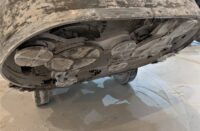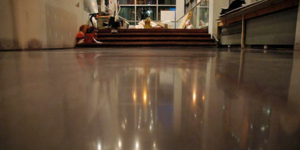
Polishing concrete on the surface (ha-ha) seems reasonably straightforward. Buy the right equipment, attach diamond tooling, turn on the equipment and “mow” the concrete. Do this one row at a time and repeat with finer grits. How hard can this be? Well, that just might be the first problem.
How hard is it? And how much energy/labor/time does it take to grind or break through the cap? All concrete slabs are different, even if they’re the same mix design at the same location. Following are just some of the variables that I’ve encountered over the years. I recommend combining mechanical and chemical processes, because together nothing is impossible.
Concrete and its unlimited variables
Numerous variables affect the outcome of polished concrete, including:
- Environmental conditions – Airflow, barometric pressure, humidity, temperature, direct or indirect exposure to the sun or other elements like rain and snow.
- Site conditions – Site compaction, soil stabilization, number of levels and accessibility, no walls, some walls, walls but no windows, cross breeze/ventilation, enclosed, conditioned-enclosed space.
- Concrete variables – Manufactured or human-made aggregate, clean aggregate, dry or wet aggregate, clean fine aggregate (sand), dry or wet, clean water, contaminated water, different geographic locations of quarries, aggregate hardness levels, cement manufactured at different locations, cement substitute differences, the timing of the mixing delivery and placement.
- Contractor variables – Level of expertise, equipment condition, quality of equipment, number of laborers, attitudes, attention to detail.
Overcome concrete’s obstacles with treatments
Pre-grind treatments can help improve the concrete’s appearance even before placing diamonds onto the concrete. They can also help make that first grinding step easier.
- Improvement of appearance: Manufacturers first developed this product as a pre-densifier treatment, and now it’s found a second home. These products help remove laitance, salt deposits and haze that often occur due to wet-curing, blanket-curing and unfortunate differential curing. By removing this surface contamination, the diamonds come in contact with the actual slab and can refine/scratch and cut sharply.
Product usage: Apply the product, gently scrub and rinse. Use this product when polishing a cream finish (CPC Class A). It promotes uniformity of color and surface appearance.
- Grinding aids: These products help diamonds become effective at removing the hard/burnt cap that forms on over-troweled or previously densified concrete. When the concrete stays wet, is slightly etched or softened, and the surface tension breaks, the polishers will uniformly grind at an average pace during the first cut.
These chemicals offer great assistance when exposing aggregate or sand finish. Benefits include significantly reduced diamond usage, fewer passes and reduced labor (up to 30% less) during the first cut. The downside entails using a slightly acidic product, the added product cost and the treatment time.
Product usage: Apply product until the surface wets out and becomes darker and has mostly been absorbed. Then grind normally. The objective of this product is to pre-soften a hard-troweled concrete surface.
Here’s the tip: Water is nature’s treatment
These beneficial pre-grind products certainly produce results. However, we’re rarely able to plan or are well enough informed in advance to have these products in our vehicles. In that case, water is the next best option.
Pre-soaking a slab sometimes for more than 24 hours can make a huge difference. And, of course, wet cutting is more aggressive and can help too! Again, pre-grind treatments can benefit a project when used in conjunction with polished concrete equipment and diamond tooling.
Think out of the box, keep an open mind and file this information away for that proverbial rainy day!
















